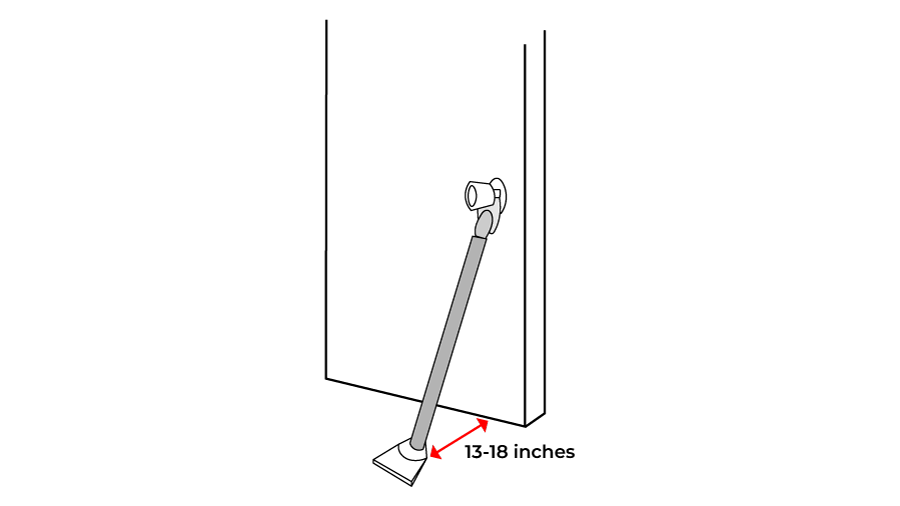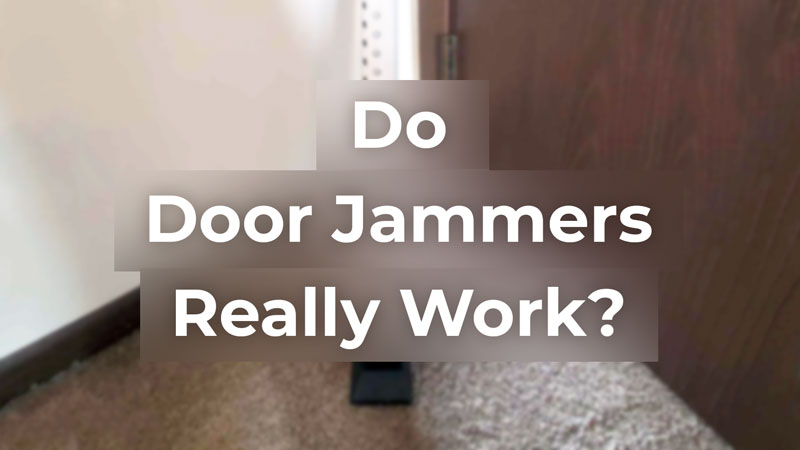There are many ways you can secure a door from the inside, however, not all methods are equally effective.
In fact, there are huge differences between security devices when it comes to sturdiness and reliability.
Door jammers are popular tools, and many people use them to improve door security and prevent burglaries and other unauthorized entries.
How much should you rely on these devices? How effective are they? This is exactly what we’re going to examine in this article.
Door jammers are moderately effective security devices. They offer a quick and simple way to add extra security to a standard residential door. While a high-quality door jammer can withstand substantial forces when used properly, much depends on the actual model and the strength of the door.
What Are the Main Types of Door Jammers
There are 2 main types of door jammers: fixed and portable jammers.
Fixed door jammers are less common, and most people mean a portable security device by a door jammer. Therefore that’s the group we’ll have a closer look at.
The most common portable door jammers are security door bars, door lock braces, and door wedges.
A security door bar is a long metal bar with an adjustable height. It’s a kind of door brace that you need to place under the door handle (door knob or lever) while the other end rests on the floor.
A door lock brace, such as DoorJammer, is a much smaller device than a door bar that you need to slide under the bottom of the door.
A door wedge (aka door stop) is an even smaller, triangular-shaped device that’s usually made of rubber. You have to place it between the bottom edge of the door and the floor to prevent the door from moving.
To be honest, you shouldn’t expect too much from door wedges, so I won’t talk about them in the following sections. While a door wedge can indeed delay an intrusion, its effectiveness is inferior to that of a door security bar or door lock brace.
If you want to know how you can get the most out of a door wedge, check out this article.
Do Door Jammers Work? What Can You Expect From a High-Quality Model?
A high-quality door jammer, when used properly, is an effective device to secure a door from the inside.
What does it mean exactly?
Provided that a door jammer is correctly set up (more on that later), it should withstand at least 4-5 kick-in attempts. Certain models can withstand up to 2,500 lbs of force. A security door bar is usually more resistant to high-force attacks than a door lock brace.
As you can see, door jammers work but I would like to emphasize that a cheap, low-quality product will only give you a false sense of security, especially when the setup is also incorrect.
However, even if you use a device of excellent quality and the right way, chances are good that it won’t stop determined intruders in itself.
If security is a concern, never ever rely solely on a single door jammer. Instead, use it as an additional layer of security.
Keep in mind that while a door jammer provides a real physical barrier, it relies on the strength of the door handle and the door itself.
What Criteria Must a Door Jammer Meet?
Not all door jammers are created equal. Some models are of extremely poor quality and they’ll break at the first major impact. So they’re not effective at all, to put it mildly. A few of them are hard to use or not compatible with certain types of doors.
Here’s what to look for when choosing a door jammer:
- A door jammer must be sturdy and well-constructed. It should withstand at least 5 full-force kicks and several low-force impacts. It must have a solid and robust body made from steel or some kind of heavy-duty alloy.
- It must have a non-slippery foot with a high level of adhesion and a large surface area in contact with the floor.
- It must be compatible with your door and floor. A tile floor can be especially tricky, and not all models will adhere. Adjustable height is a common feature, which is useful when you want to use the jammer for different doors.
- Finally, a door jammer should be easy to both install and remove without any tools.
The weakest parts of most door jammers are the foot (or base) and the section that allows you to adjust the height of the bar. So take a close look at these parts before buying. I suggest that you avoid any model that has plastic parts.
Here’s an example of a heavy-duty device, called Buddybar Door Jammer:
What Is the Correct Setup?
Correct installation of your door jammer is crucial. If you fail to set up your device the proper way, your door security may be seriously compromised.
Here’s how to install a door jammer the right way:
- As a first step, make sure the door jammer is in a closed position (so it’s not extended).
- Place the door jammer against the door: one end should touch the door, while the other rests on the floor.
- Adjust the height of the device so that the yoke fits snugly against the underside of the door handle.
- Slide the foot of the door jammer towards the door until it’s 13-18 inches from the bottom of the door and you get a snug fit.
- Test the setup and make sure the door can’t be opened and the door jammer stays securely in place.
- Never use it on mats, loose rugs, or uneven surfaces.

These are the main steps to set up a door jammer for maximum protection. If you want your door jammer to work, you must install it the right way.
Make sure you also read the manual of your own device, as it may contain some important details that are specific to that exact model.
Pros and Cons of Door Jammers
Advantages
- A portable door jammer is very easy and quick to install as it does not require any tools (no drilling or screwing).
- Most models are affordable, although high-quality security door bars are not cheap.
- While many door jammers are designed for hinged doors, a door security bar can also be used to secure a sliding door.
- Many models are portable, which makes them ideal for renters and travelers.
- Can (and often should) be used in combination with other security devices and door locks to increase effectiveness.
Disadvantages
- Incorrect installation can give you a false sense of security.
- For front doors or other entrances where a high level of security is expected, a door jammer won’t provide enough protection in itself but can serve as an additional layer of security.
- Door jammers may slow down but won’t stop determined and experienced intruders.
- Some models won’t work on certain types of tiles and carpets, so double-check the specifications if you want to use yours on tiled or carpeted floors.
- Incompatibility issues may arise with certain types of doors and handles.
When You Should and Shouldn’t Use a Door Jammer
Using a door jammer can be a great way to add extra protection to a door in many situations, including the following:
- If your door has a weak or poor-quality lock, you can use a door jammer to temporarily improve security.
- If you’re a renter and not allowed to make any permanent changes but want to increase the level of security, a door jammer can be a reasonable choice to reinforce your apartment door.
- If you share an apartment with others and want to secure your bedroom door for privacy reasons.
- When you’re staying in a hotel room or other unfamiliar location.
- If you’re worried about security and want to reinforce your door using several different devices, adding a door jammer may give you peace of mind.
There are some situations where using a door jammer might not be the best choice, including:
- Do not use a door jammer on an exterior door, such as a front door or back door, without any other protection. On these types of doors, you must also have a permanent security device installed. Here’s how you can improve front door security.
- A door jammer cannot be inactivated from the outside, so you can unintentionally lock a family member out of the house.
- It’s not ideal on high-traffic doors.
Alternatives to Door Jammers
Door jammers can be useful security additions to many doors, however, they only provide a moderate level of security at best. This means, in most cases, they cannot protect an exterior door if there are no other security measures taken.
If security is a real concern, I highly encourage you to add an ANSI Grade 1 deadbolt lock to your entry door and strengthen the weakest parts of your door as a first step. You will find more information about the different types of door locks here.
A great alternative to a door jammer is a keyless door reinforcement lock. It’s a small device that you need to install on the door jamb and can withstand up to 800 lbs of force. It’s sturdier and more robust than standard sash jammers.
You can also significantly improve home security by adding a fixed door jammer, such as a door barricade, to your door. One of its major advantages is that it’s anchored to the floor, so it doesn’t depend on the strength of the door frame. Besides standard hinged doors, it works on double doors and French doors as well.
For traveling purposes, the Addalock portable door lock may be worth having a look at as it can be a viable alternative to a door jammer.
These devices can also be used in combination with a door jammer. If you need to secure a door without a lock, here are my best suggestions.












